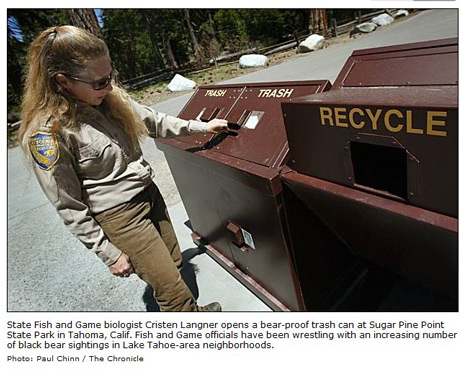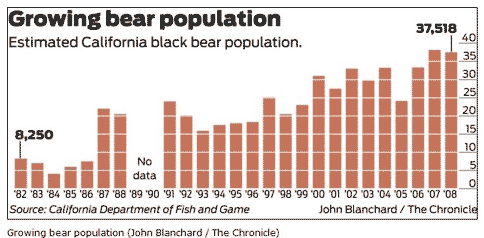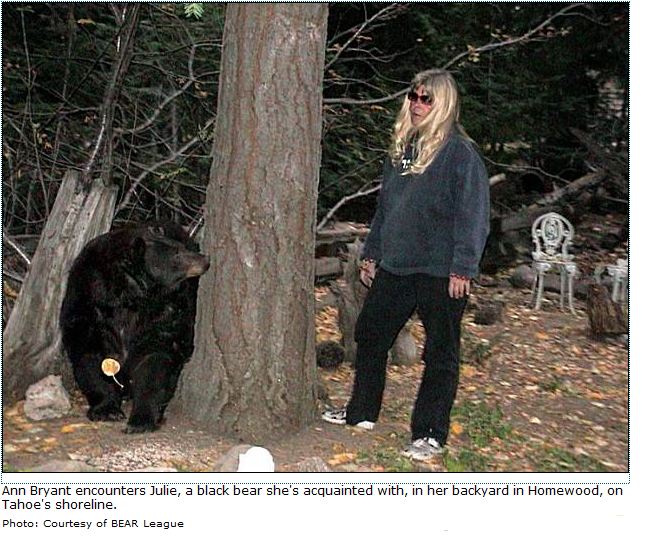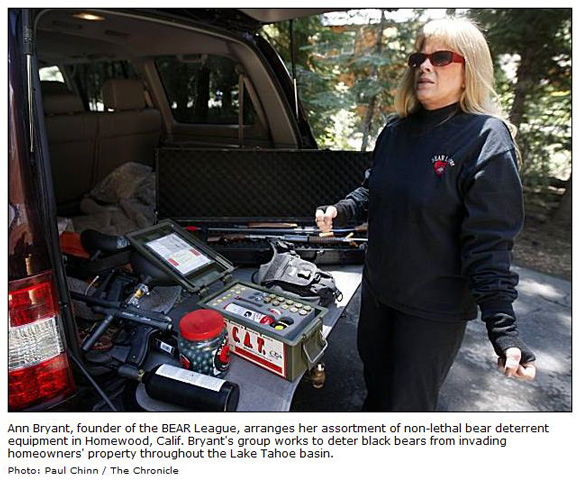 |
|
Tahoe's bear break-ins force killingsPeter Fimrite, Chronicle Staff Writer |
|
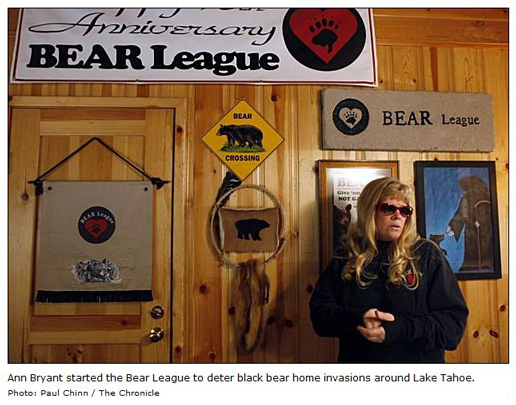 |
|
The black bears of California came out of hibernation this spring with an unusually large number of cubs and a hankering for groceries. It is a deadly combination for the bears, wildlife officials say. More bear cubs than anyone can remember are waddling behind their mothers, gobbling up unlocked food, rummaging through household debris and raiding refrigerators, especially in the Lake Tahoe area, bear biologists said. The large number of break-ins has led to a surge in ursine exterminations. Eleven problem bruins have already been bumped off by wildlife rangers in the Lake Tahoe region of California and Nevada. The numbers illustrate just how difficult it is for humans to coexist with wildlife, especially when the wildlife is big, burly and brazen. "It seems like they've changed their behavior from breaking into (people's trash) to breaking into homes," said Cristen Langner, a wildlife biologist for the California Department of Fish and Game, who specializes in managing the bears in the Tahoe basin. It is a problem that has been steadily growing over the years. The stampede this spring and summer comes on top of a huge increase over the past few decades in the number of bears in California.
In 1984, there were 4,080 American black bears in the state, according to Fish and Game statistics. There were 17,500 in 1994. By 2008, the number had grown to 37,518, officials said. The bears are concentrated in forested mountain ranges but have increasingly been spotted outside those regions, including in Sonoma County and at least once in Marin.
More cubs than ever The numbers - calculated using a statistical model based on the age and gender of bears killed by hunters - have not yet been tallied for last year or this year, but many sows in the Tahoe area have been spotted with as many as three cubs in tow. Two cubs are common for well-fed bears. Three usually indicates an abundance of food, which often means garbage slop. "We've had more cubs than ever before, and that's a worry," said Ann Bryant, executive director of the Bear Education Aversion Response League, an advocacy group based on the west shore of Lake Tahoe. "It means all the breeding-age bears are having babies, which is a good thing, but they are raising them right in our neighborhoods." Marc Kenyon, Fish and Game's statewide black bear program coordinator, said the extermination in the 19th and early 20th centuries of California's grizzly bears is at least partially to blame for the black bear population explosion. The last California grizzly was killed in 1922. "The black bears are moving into areas they were once excluded from by grizzlies," Kenyon said. "They are adapting, and because of that there are more of them." No more easy pickingsAnd the more bears there are, the more they need to eat. Until recently, black bears in Yosemite, Lake Tahoe and other tourist-oriented areas simply knocked over a garbage can when they needed a meal. But the easy pickings dried up over the past decade as park rangers and wildlife officials pushed for bear-proof garbage and camping containers. "Now the source is being cut off," Langner said, "so they are resorting to increasingly bad behavior." So far this year, rangers have killed eight bears that broke into homes or were menacing people in the Incline Village, South Lake Tahoe and Carson Valley regions. That's compared to one or two at this time during a typical year, said Carl Lackey, a wildlife biologist for the Nevada Department of Wildlife. There have been about 50 reported incidents involving bears on the California side of Lake Tahoe, which includes portions of Placer and El Dorado counties, Langner said. That includes everything from a chance encounter on the back porch to a total ursine remodeling of the kitchen. Fish and Game officials have granted 15 requests for a depredation permit, which allows for the killing of a bear, in the two counties, three of which were carried out. Early den departureBryant thinks bear encounters are up not because there are more bears, but because the bruins emerged from their dens this year in March instead of the normal May or June. "The warm spell for a while brought a lot of them out, then it got cold again and they had nothing to eat," Bryant said. "People leave their bird feeders out and feed their dogs outside. The bears don't know the food was for Fluffy. They think it is for them." Bryant believes state officials are pushing the population explosion theory because they want to relax California's 1,700 bear bag limit, particularly in Siskiyou and Humboldt counties, where bear hunting is popular. It is a belief shared by Brian Vincent, the spokesman for the conservation group Big Wildlife, who claims legal hunting provides cover for poachers and may actually be driving bears out of the wilderness into populated areas, where they get into trouble. "How does shooting a bear in the woods address the issue of problem bears in the towns?" said Vincent, pointing out that California is also facing a poaching epidemic, including the illegal trade in bear gall bladders, which are believed in Asian countries to have medicinal qualities and can fetch $2,000 an ounce. "The department needs to develop better wilderness corridors for bears to travel and put more effort into public education instead of accommodating trophy hunters," he said. Fish and Game officials said they are doing everything they can to address the problem, including scaring problem bears with specially trained dogs, but, short of reintroducing grizzlies, the options are limited. About black bearsColor: Vary from tan or brown to black. Size: Adults typically weigh from 100 to 350 pounds. Range: Throughout North America, mostly in mountainous areas above 3,000 feet. Population: More than 37,000 are believed to live in California. Source: California Department of Fish and Game
E-mail Peter Fimrite at pfimrite@sfchronicle.com. |
|
